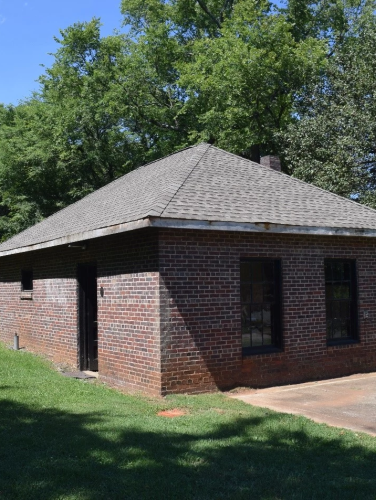
Huntersville Town Jail
(ca. 1935)
Huntersville’s oldest surviving municipal building served as the town’s only local jail for nearly three decades.
301 Huntersville-Concord Road, Huntersville, NC 28078
The Huntersville Town Jail is the town’s oldest surviving municipal building. The town previously relied upon a one-room building constructed in the late 1800s or early 1900s to detain persons suspected of criminal activity. The earlier building had no cells, plumbing, or heat. That inherently unsecure jail had but one door and two small, barred windows. The new brick jail, constructed about 1935 near what was then Huntersville’s commercial center, featured a more secure free-standing two-cell iron and steel cellblock. The building represents the development and expansion of local law enforcement during the first half of the 20th century, a period of fundamental change as Mecklenburg County transitioned from an agricultural economy to one based increasingly on manufacturing, trade, and transportation. The jail building also bears witness to the period of unprecedented public works projects during the Great Depression, although there is no evidence that the jail itself was funded as part of such federal New Deal programs as the Works Progress Administration or the Public Works Administration.
Property Quick Links
Crime was a serious and persistent problem in rural Mecklenburg County during the early decades of the 20th century. Several factors contributed to the problem, including economic circumstances associated with the Depression, illicit production and sale of alcohol, and limited law enforcement resources spread over a large, rapidly growing and developing county. The Huntersville Police Department dates back to at least 1929. Prior to the formation of that local force, the area’s law enforcement was handled by the Rural Police, a force organized in 1917. The Rural Police did not prove particularly effective until 1925 when it became an independent law enforcement agency reporting directly to the County Commission.
Huntersville’s new jail may have been built by Ruffus McCay, a brick mason who constructed many of the buildings around Huntersville in the 1930s. The spartan building was divided into two rooms by a solid masonry wall with a single central doorway. The front room was an office, and the cell block was located in the back room. The office contained the only exterior door and a flue for a wood, coal, or oil heater that heated the entire building. In the back room, one cell – measuring 5’6” by 8’ – featured two iron bunks; the larger 6’6”-by-8’ cell contained three bunks. Each cell had a toilet.
Although Mecklenburg County residents voted in 1937 to keep the county “dry,” public drunkenness appears to have been the most consistent crime in Huntersville when the town jail was in use. In general, the jail stood empty most of the time, as most prisoners were typically taken to the county jail in downtown Charlotte. The police chief did not keep an office in the town jail, and the town’s police officers generally worked out of their patrol cars. Throughout most of the 1940s, the jail was the only building owned by Huntersville and was used as a voting site. No longer used as a jail after 1963, the building became a storage facility for the town.

